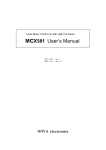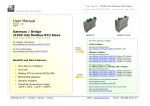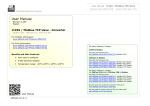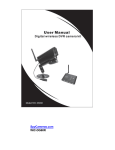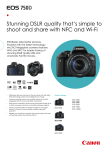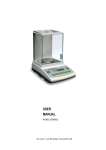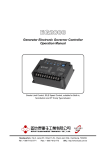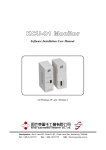Download User Manual - Kutai Electronics
Transcript
DSP-52 J1939 CAN-Bus Reader Manual For CAN-Bus SAE-J1939 Protocol Headquarters : No.3, Lane 201, Chien Fu ST., Chyan Jenn Dist., Kaohsiung, TAIWAN Tel : + 886-7-8121771 Fax : + 886-7-8121775 URL : http://www.kutai.com.tw DSP-52 CAN-Bus Reader TABLE OF CONTENTS Section Page 1. CHAPTER ONE INTRODUCTION 1.1 Introduction ...................................................................................................................................... 3 1.2 Product Description.......................................................................................................................... 3 1.3 DSP-52 Electrical Characteristics.................................................................................................... 3 2. CHAPTER TWO HARDWARE INTRODUCTION 2.1 DSP-52 Outline Dimension.............................................................................................................. 4 2.2 DSP-52 Pin-Out Diagram ................................................................................................................ 5 3. CHAPTER THREE FUNCTION DESCRIPTION AND OPERATE INDICATION 3.1 DSP-52 Startup Cover Page............................................................................................................ 6 3.2 Analogy And Digital Gauge.............................................................................................................. 6 3.3 Custom Common Display Gauge .................................................................................................... 7 3.4 Curve Graphics Record ................................................................................................................. 10 3.5 Adtc Message ................................................................................................................................ 12 3.6 Syatem Setting............................................................................................................................... 13 4. CHAPTER FOUR APPENDIX 4.1 J1939 Network Topology ............................................................................................................... 19 4.2 DSP-52 Parameter Setting Table .................................................................................................. 19 4.3 Spn Item Correspond Icon Table................................................................................................... 20 4.4 DSP-52 Spn Item Chinese And English Bilingual Table (SAE-J1939-71) .................................... 20 4.5 J1939 Fmi Description ................................................................................................................... 21 ______________________________________________________________________________________ 2 DSP-52 CAN-Bus Reader 1. CHAPTER ONE INTRODUCTION 1.1 Introduction Electronically controlled engines are becoming ever popular. The data from various control components are communicated through a fast and stable network (CAN-Bus). Since the release of SAE-J1939 protocol, different manufacturers are now able produce products that can operate and communicated according to the unified definition of data communication. The baud rate from SAE-J1939 in CAN-Bus is limited to 250k Bits/s. In network length of 40 meters with maximum of 10 nodes (ECUs ), in network length of 10 meters with maximum of 30 nodes (ECUs ). It does not support master-slave network or allows the Plug & Play and other features. 1.2 Product Description The DSP-52 CAN-Bus Reader is used to interpret the SAE-J1939 protocol’s parameters and diagnostic codes, and graphically display the information on the LCD panel. The arrangement of display, the measuring units and language can be customized according to the user preference. Overall, a DSP-52 is used to simplify and replace multiple display meters and gauges. 1.2.1 Features ● Large single color LCD with graphical display ● Hidden multi-function menu ● Single click to return to graphical display menu DSP-52 Network Structure Diagram 1.3 Electrical Characteristics ITEM DC Supply CAN Bus Protocol CAN Bus Baud Rate RS-485 Protocol RS-485 Baud Rate Contact Capacity Power Consumption Water-Resistance SPECIFICATION 8~60 VDC SAE-J1939 Protocol 250 k BPS Mod Bus Protocol 38400 BPS 1A or 30VDC Max@10VA <2W IP67 (Below Water 1 Meter) Operate Temperature -10℃ ~ 70℃ Storage Temperature -20℃ ~ 80℃ Relative Humidity Weight up to 100% 555g ±2% (include harness total 700 g) ● 4 pages display arrangement with total of 16 graphical display readouts and 4 readouts per page ● 8 item data tracking and curve graph displayed ● Records up to 100 failure code history (ADTC) ● 1 failure warning output ● RS-485 port for system remote access ● IP67 Water-Resistance (Below Water 1 Meter) 1.2.2 Network Structure The DSP-52 receives the SAE-1939 data packet via CAN-Bus from the ECU and graphically displays the value on the LCD screen. By connecting through RS485 port user can remotely monitor and access the DSP-52. ______________________________________________________________________________________ 3 DSP-52 CAN-Bus Reader 2. CHAPTER TWO HARDWARE DESCRIPTION 2.1 Outline Dimension (Unit : mm) J1939 CAN-Bus Reader 4 6 0 2 250 8 0 X1000 500 750 1000 600 4819 RPM KPa 120 90 60 30 11 110 0 °C 6 16 20 25 30 22.5 Vdc ______________________________________________________________________________________ 4 DSP-52 CAN-Bus Reader 2.2 Pinout Diagram ITEM 1 2 3 4 5 COLOR Red Pink Gray Yellow Green DESCRIPTION CAN Bus Shield Alarm Contact Output Alarm Contact Output Spare terminal CAN_H 6 White CAN_L 7 Blue 8 Brown Spare terminal Battery - ITEM 9 10 11 12 13 COLOR Red / White Brown / White Black / White Light Green Purple 14 Orange DESCRIPTION Spare terminal Spare terminal Spare terminal Spare terminal RS485 D+ RS485 D 15 Black Battery + - ______________________________________________________________________________________ 5 DSP-52 CAN-Bus Reader 3. CHAPTER THREE FUNCTION DESCRIPTION AND OPERATE INDICATION 3.1 DSP-52 Startup Cover Page The DSP-52 displays a startup cover page for 5 seconds. The startup cover page can be self customized. User can upload a 320 × 240*1-bit BMP picture file to the system memory via remote access software. After rebooting the system, the startup cover page will be updated to the new design. 3.2 Analogy and Digital Gauge 16 graphical analogy and digital gauges can be rearranged in the preferred sequence of 4 display gauges per page from the total of 4 pages (For more information please reference from Chapter 3.3 “Customize Common Display Gauge”) Press “Next Page” to change to next display screen. 3.2.1 Analogy Gauge Page 1 Common Analogy Gauge Page 2 Common Analogy Gauge Page 3 Common Analogy Gauge DSP-52 Default Startup Cover Page DSP-52 Customized Startup Cover Page ______________________________________________________________________________________ 6 DSP-52 CAN-Bus Reader 3.2.2 Digital Gauge 3.3 Customize Common Display Gauge In the Analogy and Digital Gauge display, press Customizing Display Gauge key , user can select to switch and change the corresponding gauge combination as desired. (For example : Press key the bottom left gauge will be changed to a different gauge display. The order of switch can be referenced from Chapter 3.3.1 “Common Gauge List” ). Page 4 Common Digital Gauge 3.2.3 Gauge Menu Bar Press any key, the menu bar will appear at the bottom of the LCD display screen with 6 functions keys corresponding to the push bottom below the LCD screen. If no buttons are pressed in 5 seconds, the menu bar will disappear to provide more detailed graphical display. Customize Common Display Gauge Screen Switch Top-Left Gauge Switch Top-Right Gauge Switch Bottom-Left Gauge Switch Bottom-Right Gauge Return to Previous Page Home (Back to Gauge Display) Graphical Gauge Menu bar screen Next Page Curve Graphics ADTC Record System Setting Customizing Display Gauge Home ______________________________________________________________________________________ 7 DSP-52 CAN-Bus Reader 3.3.1 Common Gauge List 1. Engine Speed 2. Engine Coolant Temperature 3. Key switch Battery Potential 4. Battery Potential / Power Input 5. Engine Intake Manifold Pressure 6. Engine Oil Pressure 7. Engine Intake Manifold Temperature 8. Engine Percent Load at Current Speed ______________________________________________________________________________________ 8 DSP-52 CAN-Bus Reader 9. Accelerator Pedal Position 13. Trip Distance 10. Engine Fuel Rate 14. Total Vehicle Distance 11. Engine Total Hours of Operation 15. Fuel Level 12. Wheel-Based Vehicle Speed 16. Distance Remaining ______________________________________________________________________________________ 9 DSP-52 CAN-Bus Reader 3.4 Curve Graphics Record 3.4.1 Curve Graphics Item List DSP-52 offers 8 curve graphics records, with programmable recording time from 4, 8, 16, 32, 60 minutes, 2, 4, and 8 Hours (For more information please reference from Chapter 3.6.1.4 “Meter Range Setting”). This function allows user to understand the variation in value during the recording time. The system does not save the record, new curve graphics will be supplied when system reboots. 1. Engine Speed 2. Engine Coolant Temperature Curve Graphics Record Screen Analogy and Digital Gauge Display Function Switch to Next Curve ADTC Record Function Enter System Setting Function 3. Key switch Battery Potential Hide Menu Bar Home (Back to Gauge Display) ______________________________________________________________________________________ 10 DSP-52 CAN-Bus Reader 4. Battery Potential / Power Input 7. Engine Intake Manifold Temperature 5. Engine Intake Manifold Pressure 8. Engine Fuel Rate 6. Engine Oil Pressure ______________________________________________________________________________________ 11 DSP-52 CAN-Bus Reader 3.5 ADTC Message 3.5.1 ADTC Warning DSP-52 can record up to 100 failure code history ADTC (Active Diagnostic Trouble Code). Precisely records engine operating hours, number of occurrence, SPN (Suspect Parameter Number), FMI (Failure Mode Indicator) and warning lamp indicator. In an ECU failure warning, the LCD screen flashes continuously. Press any key and the screen will immediately switch and locked in the active warning page until the ECU failure warning is excluded to resume operation of the DSP-52. ADTC Message with Menu Bar ADTC Warning Flash Page Previous ADTC Record Next ADTC Record Mute Delete All ADTC Record Return to Last Function Home (Back to Gauge Display) Warning Lamp Icon: Malfunction Indicator Lamp ADTC Message Lock at Active Warning Page Red Stop Lamp Mute Amber Warning Lamp Home (Back to Gauge Display) Protect Lamp ______________________________________________________________________________________ 12 DSP-52 CAN-Bus Reader 3.6 System Setting 3.6.1.1 Unit Setting System setting is divided into three categories: The measuring and display units for distance, pressure, volume and temperature can be programmed according to user preference. 1. Setting Page 2. System Page 3. J1939 Item List 3.6.1 Setting Page To Adjust and set the display units, language, operating beep sound, meter range, service maintenance schedule, engine fuel tank capacity, and LCD brightness. Unit Setting Screen Previous Unit Setting Next Unit Setting Change Unit Setting Selection Return to Last Function Setting Page Previous Setting Item Home (Back to Gauge Display) ● Speed Unit:KM/H, MPH ● Distance Unit:KM, MILES Next Setting Item ● Pressure Unit:KPA, PSI, BAR Enter Setting Page or Change Setting Selection ● Volume Unit:LITRE, GAL ● Temperature Unit:℃、℉ Return Last Function Home (Back to Gauge Display) ______________________________________________________________________________________ 13 DSP-52 CAN-Bus Reader 3.6.1.2 Language Setting 3.6.1.4 Meter Range Setting In the language setting, the DSP-52 is currently available in Mandarin and English only. The Meter Range Setting is for setting the maximum range of the engine RPM, vehicle speed, locking of gauge display combination to prevent accidental change during operation and curve graph recording time. Language Setting Screen Previous Language Meter Range Setting Page Next Language Previous Setting Item Enter (Select Language) Next Setting Item Return to Last Function Select Last Setting Option Home (Back to Gauge Display) Select Next Setting Option 3.6.1.3 Beep Setting Return to Last Function The Beep sound for push button and failure warning can be turned [ON] and [OFF] in the Beep Setting. Home (Back to Gauge Display) ● Lock Quad Gauge Combination : [FREE] Gauge combination non-locked [LOCK] Gauge combination locked Beep Setting Screen Enter Setting Page or Change Setting Selection Gauge Combination Locked (Select Disable) ______________________________________________________________________________________ 14 DSP-52 CAN-Bus Reader ● Maximum engine RPM range setting:2000 ~ 9000 RPM. Return to Last Function ● Maximum vehicle speed range setting:100 ~ 200. Home (Back to Gauge Display) ● Curve graphic recording time range setting : 4, 8, 16, 32, 60 minutes, 2, 4, and 8 Hours. 3.6.1.5 Maintenance Service Setting In the language setting, the DSP-52 is currently available in Mandarin and English only. The maintenance service setting provides addition protection for the engine to schedule required maintenance and service. When the timer is set to 0 hour then the function is cancelled [OFF]. Press start hour reset key Example : The Start Hour Reset was first set at 37.5 of operation hour. The Maintenance Service schedule is set to perform after 300 hours of operation, therefore the scheduled maintenance Service needs to be performed at 337.5 hours (300+37.5=337.5). From the illustration below, the current total operation hour is 350 hours, therefore the scheduled maintenance service is already pass due for 12.5 hours and the “Next Service in :” will appear Now to inform user to perform maintenance immediately. to reset the Start Hour by referencing from Engine Total Hours of Operation as the next original starting hours. Maintain Service Time Up Maintenance Service Setting Page Decrease Service Hour Increase Service Hour Start hour reset key. Set Engine Total Hours of Operation as the start hour. o quickly increase or decrease the value of hour setting, press then the value became therefore when press or , the value will increase or decrease by 10. Press value became then the therefore when press or , the value will increase or decrease by the 100. ______________________________________________________________________________________ 15 DSP-52 CAN-Bus Reader 3.6.1.6 Fuel Capacity Setting 3.6.1.7 LCD Brightness DSP-52 able to interpret the SAE-J1939 packet message, but in order to calculate correct remaining fuel capacity, user must first program the correct fuel tank capacity. The LCD brightness can be adjusted from 10 ~ 100%. The Remaining fuel = fuel tank capacity × level LCD Brightness Setting Page Decrease LCD Brightness Level Fuel Capacity Setting Page Increase LCD Brightness Level Decrease Fuel Capacity Return to Last Function Increase Fuel Capacity Return Gauge Display To quickly increase or decrease the value of fuel tank capacity setting, press then the value became when press or therefore , the value will increase or decrease by 10. Press then the value became therefore when press or , the value will increase or decrease by the 100. Press then the value became therefore when press or , the value will increase or decrease by the 1000. Return to Last Function Home (Back to Gauge Display) ______________________________________________________________________________________ 16 DSP-52 CAN-Bus Reader 3.6.2 System Page 3.6.2.2 RS-485 Setting System Page is divided into four categories: DSP-52 is equipped with RS-485 communication port for connecting with PC program (DSP-52 Remote). The advantage for RS485 are the long range connections from 500 up to 1000 meters), and high interference-free capability. The selected baud rate is 38400 Bits / Sec, compliant with the ModBus protocol with CRC-16 packet to test and confirm the accuracy of data. The slave address is to enable the PC program (DSP-52 Remote), to simultaneously connect to multiple controllers. For PC program connection details please refer to the DSP-52 Remote user manual. 1. RESTORE DEFAULTS 2. RS-485 SETTING 3. J1939 SETTING 4. ABOUT DSP-52 3.6.2.1 Restore Defaults In the Restore Defaults, by pressing [Yes] all customized settings will automatically reset to the factory original setting. (For more information please reference from Chapter 4.2 “DSP-52 Parameter Setting Table”) RS-485 Setting Page Slave Address -1 LCD Brightness Setting Page Slave Address +1 Previous Setting Item Return to Last Function Next Setting Item Return Gauge Display Select Setting Option Return to Last Function Return Gauge Display DSP-52 Remote RS-485 Network ______________________________________________________________________________________ 17 DSP-52 CAN-Bus Reader 3.6.2.3 J1939 Setting 3.6.2.4 About DSP-52 Not all J1939 parameters are automatically transmitted. Some parameters need to be requested by controller to the system, and submit a request packet message with a request address (J1939 address set 1 ~ 254). The system will then respond to the corresponding parameters. DSP-52 can also set whether to respond to the request or not, and set the time interval in between each request from 1 ~ 30 seconds. This page contains information of the manufacturer’s and DSP-52 related information which includes, model name, bar code serial number, software version and CAN-Bus SAE-J1939 protocol. About DSP-52 Page Return to Last Function Return Gauge Display J1939 Setting Page Last Setting Item 3.6.3 J1939 Item Viewer Next Setting Item DSP-52 provides dozens of common parameters from the J1939 decoding library. User can view the complete list of parameters in this page. Select Last Setting Option Select Next Setting Option Return to Last Function Return Gauge Display DSP-52 PGN Item Request: 0x00FE8C : Auxiliary temperature Auxiliary pressure (SPN1387) (SPN441), 0x00FEDE:Engine air start pressure (SPN82) 0x00FEE5 : Engine total hours of operation (SPN247) 0x00FEE9:Engine trip fuel consumption (SPN182), Engine total fuel used (SPN250) J1939 Viewer Page Last Page ※ PGN : Parameter group number Next Page Return Last Function Return Gauge Display ______________________________________________________________________________________ 18 DSP-52 CAN-Bus Reader 4. CHAPTER FOUR APPENDIX 4.1 J1939 Network Topology SAE-J1939-11 protocol document defines the J1939 network topology and related provisions. For example from the following illustration, the number of ECU controller (n) is based and limited to the length of the main network. In a 40 meter network, the maximum number of nodes (ECUs) is 10 and if the network within 10 meters in length then maximum number of nodes (ECUs) is 30. J1939 Network Topology ● Network to Node ECU Distance I:< 1m ● Node to Node ECU Distance d:0.1m ~ 40m ● Network Distance L:< 40m ● Terminating Resistor RL:Standard 120Ω, 110Ω ~ 130Ω (400mW) 4.2 DSP-52 Parameter Setting Table NO 1 2 3 4 5 6 7 8 9 10 11 12 13 14 15 CONTENT Speed unit Distance unit Pressure unit Volume unit Temperature unit Language Beep Quad gauge adjust Max engine speed Max vehicle speed Graph time range Maintain service setting Fuel capacity LCD brightness RS-485 slave address setting SETTING KM/H, MPH KM, MILES KPA, PSI, BAR LITRE, GAL ℃, ℉ English, Traditional Chinese On, Off Free, Lock 2000 ~ 9000 RPM 100 ~ 200 4, 8, 16, 32, 60 Mins, 2, 4, 8 Hours 0 (OFF) ~ 9999 Hours 0 ~ 10000 LITRE 10 ~ 100 % 1 ~ 127 DEFAULT KM/H KM KPA LITRE ℃ English On Free 8000 200 32 Mins OFF 1000 LITRE 50% 6 ______________________________________________________________________________________ 19 DSP-52 CAN-Bus Reader 4.3 SPN Item Correspond Icon Table ICON ITEM NAME ICON ITEM NAME Engine speed Accelerator pedal position Engine coolant temperature Engine fuel rate Key switch battery potential Engine total hours of operation Battery potential / power input Wheel-based vehicle speed Engine intake manifold pressure Trip distance Engine oil pressure Total vehicle distance Engine intake manifold temperature Fuel level Engine percent load at current speed Distance remaining 4.4 DSP-52 SPN Table SPN 16 1382 51 52 82 84 91 92 94 96 97 98 100 102 103 105 106 107 108 109 110 111 114 115 123 127 DESCRIPTION Fuel remaining Distance remaining Service hours (machine hours) Engine fuel filter (suction side) Differential pressure Engine throttle position Engine intercooler temperature Engine air start pressure Wheel-based vehicle speed Accelerator pedal position Engine percent load at current speed Engine fuel delivery pressure Fuel level Water in fuel indicator Engine oil level Engine oil pressure Engine intake manifold pressure Engine turbocharger speed Engine intake manifold temperature Engine air inlet pressure Engine air filter differential pressure Barometric pressure Engine coolant pressure Engine coolant temperature Engine coolant level 14 net battery current Alternator current Clutch pressure Transmission oil pressure SPN 157 158 161 164 167 168 172 173 174 175 176 177 182 183 184 185 190 191 244 245 247 250 441 512 513 515 517 523 524 DESCRIPTION Engine injector metering rail 1 pressure Keys witch battery potential Transmission input shaft speed Engine injection control pressure Charging system potential (voltage) Battery potential / power input Engine air inlet temperature Engine exhaust gas temperature Engine fuel temperature Engine oil temperature Engine turbocharger oil temperature Transmission oil temperature Engine trip fuel Engine fuel rate Engine instantaneous fuel economy Engine average fuel economy Engine speed Transmission output shaft speed Trip distance Total vehicle distance Engine total hours of operation Engine total fuel used Auxiliary temperature 1 Driver’s demand engine - percent torque Actual engine - percent torque Engine’s desired operating speed Navigation - based vehicle speed Transmission current gear Transmission selected gear ______________________________________________________________________________________ 20 DSP-52 CAN-Bus Reader SPN DESCRIPTION torque SPN 573 Transmission engaged converter lockup 975 1136 1137 1138 Estimated percent fan speed Engine ecu temperature Engine exhaust gas Port 1 temperature Engine exhaust gas Port 2 temperature DESCRIPTION 1172 Engine turbocharger temperature compressor inlet 1240 1349 1387 Engine fuel leakage 2 Engine injector metering rail 2 pressure Auxiliary pressure #1 4.5 J1939 FMI Descript FMI (Failure Mode Indicator) - The FMI defines the type of failure detected in the subsystem identified by an SPN. Note that the failure may not be an electrical failure but may instead be a subsystem failure or condition needing to be reported to the service technician and maybe also to the operator. Conditions can include system events or status that need to be reported. The FMI, SPN, SPN Conversion Method and Occurrence Count fields combine to form a given diagnostic trouble code. The “Reserved to be Assigned by SAE” FMIs will be assigned by the SAE-J1939 Control and Communications Subcommittee if additional failure modes become necessary. FMI Signal Ranges Diagram 4.5.1 FMI Region Descript Table REGION DESCRIPT a Total signal input range possible that can be seen by an electronic module. Total signal range physically possible as defined by an application. The CARB (California air b resources board) defined Rationality fault diagnostic condition is applicable anywhere in this region. c Range defined as normal for a given real world measurement. Range defined as below normal, most severe level, of what is considered normal for the given d real world measurement. Range defined as above normal, most severe level, of what is considered normal for the given e real world measurement. Range which is low outside the range of what is considered physically possible for a given f system, indicating a short to a low source has occurred. Range which is high outside the range of what is considered physically possible for a given g system, indicating a short to a high source has occurred. Range defined as below normal, least severe level, of what is considered normal for a given h real-world measurement. Range defined as above normal, least severe level, of what is considered normal for a given i real-world measurement. Range defined as below normal, moderately severe level, of what is considered normal for a j given real-world measurement. Range defined as above normal, moderately severe level, of what is considered normal for a k given real-world measurement. ______________________________________________________________________________________ 21 DSP-52 CAN-Bus Reader 4.5.2 FMI No Descript Table FMI NO 0 1 2 3 4 5 6 7 8 9 10 11 12 13 14 15 16 17 18 19 20 ~ 30 31 REGION FMI DESCRIPT e Data valid but above normal operational range d Data valid but below normal operational range Data erratic, intermittent or incorrect g Voltage above normal or shorted high f Voltage below normal or shorted low Current below normal or open circuit Current above normal or grounded circuit Mechanical system not responding properly Abnormal frequency, pulse width or period Abnormal update rate Abnormal rate of change Failure mode not identifiable Bad intelligent device or component Out of calibration Special instructions i Data valid but above normal operational range (Least severe) k Data valid but above normal operational range (Moderately severe) h Data valid but below normal operational range (Least severe) j Data valid but below normal operational range (Moderately severe) Received network data in error Reserved for future assignment Not available or condition exists ______________________________________________________________________________________ 22






















